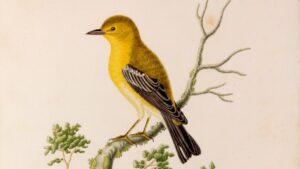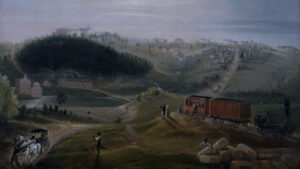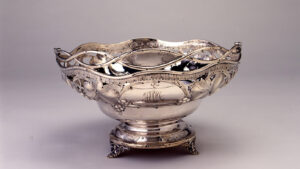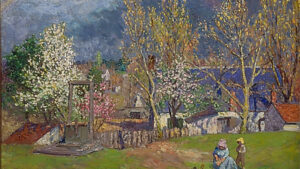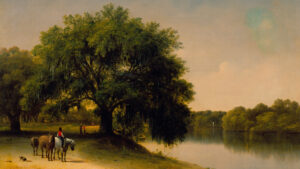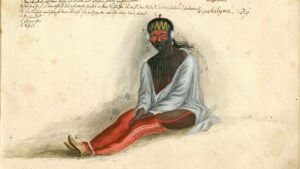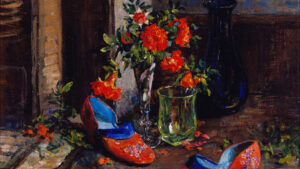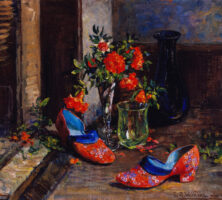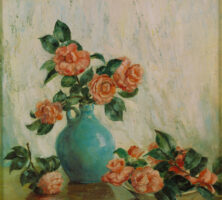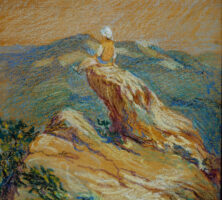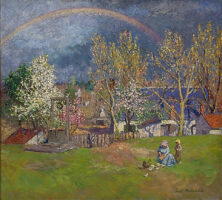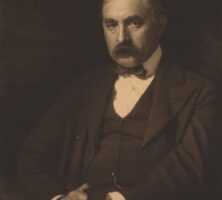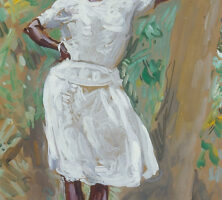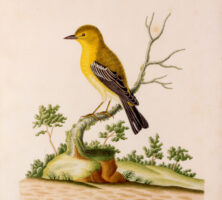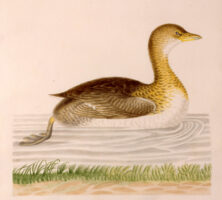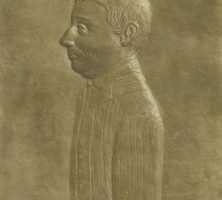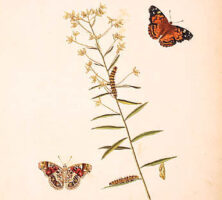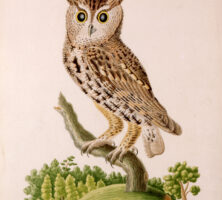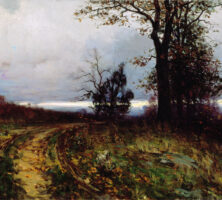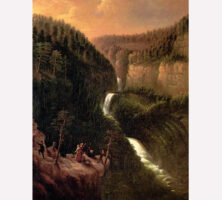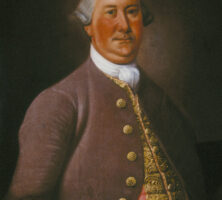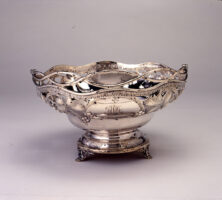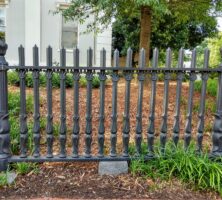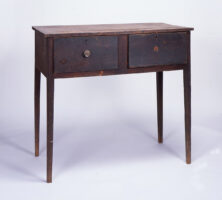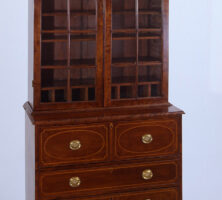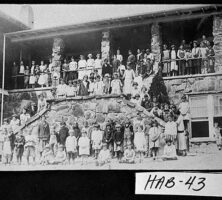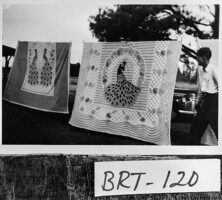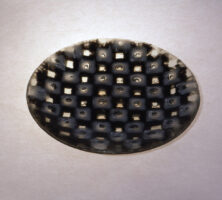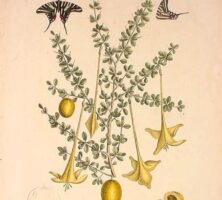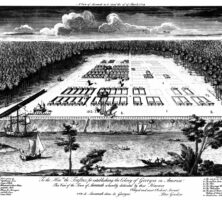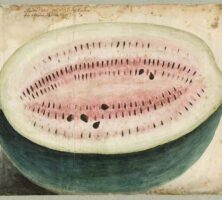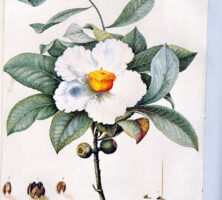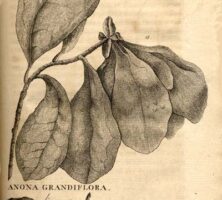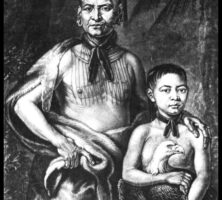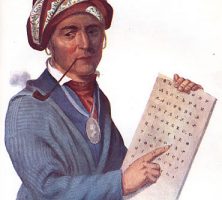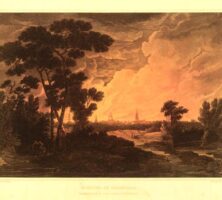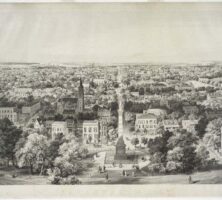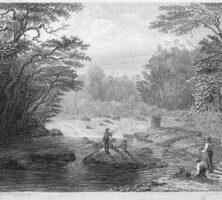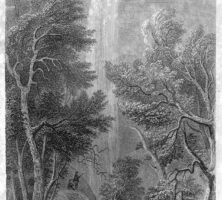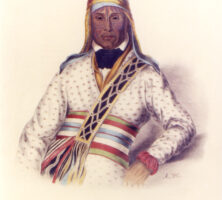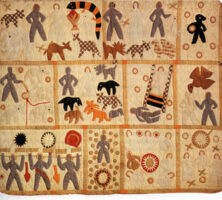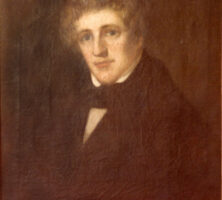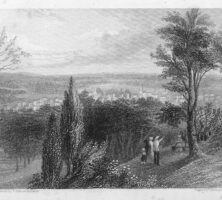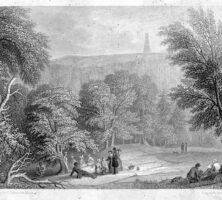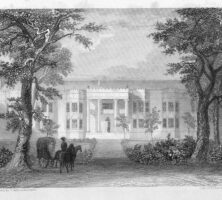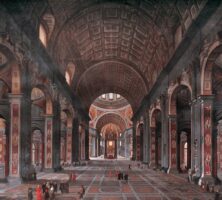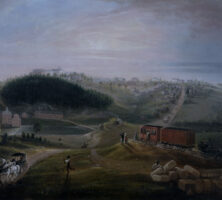The New Georgia Encyclopedia is supported by funding from A More Perfect Union, a special initiative of the National Endowment for the Humanities.
Savannah native Emma Cheves Wilkins's undated Red Shoes, Blue Vase, Glass and Carnations (oil on canvas, 20 1/4" x 24 1/8") is part of the collection at the Morris Museum of Art in Augusta.
Courtesy of Morris Museum of Art
The New Georgia Encyclopedia does not hold the copyright for this media resource and can neither grant nor deny permission to republish or reproduce the image online or in print. All requests for permission to publish or reproduce the resource must be submitted to the rights holder.
Emma Cheves Wilkins, the third generation in a family of Savannah artists, specialized in painting portraits, landscapes, and still lifes. Her undated Blue Jug and Camellias (oil on canvas, 23" x 21") is part of the collection at the Morris Museum of Art in Augusta.
Courtesy of Morris Museum of Art
The New Georgia Encyclopedia does not hold the copyright for this media resource and can neither grant nor deny permission to republish or reproduce the image online or in print. All requests for permission to publish or reproduce the resource must be submitted to the rights holder.
Youngster Sitting atop Hawks Bill, N.C. was painted by Savannah native Emma Cheves Wilkins, who is known for her impressionistic landscapes. The undated painting (pastel on sandpaper, 14 5/8" x 11 5/8") is part of the collection at the Morris Museum of Art in Augusta.
Courtesy of Morris Museum of Art
The New Georgia Encyclopedia does not hold the copyright for this media resource and can neither grant nor deny permission to republish or reproduce the image online or in print. All requests for permission to publish or reproduce the resource must be submitted to the rights holder.
Painter Gari Melchers's Rainbow (oil on canvas, 27 1/4" x 30"), an example of the artist's impressionistic style, was created circa 1925.
Courtesy of Morris Museum of Art
The New Georgia Encyclopedia does not hold the copyright for this media resource and can neither grant nor deny permission to republish or reproduce the image online or in print. All requests for permission to publish or reproduce the resource must be submitted to the rights holder.
Gari Melchers, pictured circa 1900, was a prominent painter in the late nineteenth and early twentieth centuries. A native of Michigan, he established studios in the Netherlands, Virginia, and New York City over the course of his career. In 1906 he was appointed fine arts advisor to the Telfair Academy of Arts and Sciences in Savannah, for which he acquired more than seventy works of art.
Image from Frank Scott Clark
The New Georgia Encyclopedia does not hold the copyright for this media resource and can neither grant nor deny permission to republish or reproduce the image online or in print. All requests for permission to publish or reproduce the resource must be submitted to the rights holder.
Gari Melchers's oil painting The Unpretentious Garden (33 5/8" x 40 1/2") was created around 1905 and is an example of the artist's impressionistic style.
Courtesy of Telfair Museums.
The New Georgia Encyclopedia does not hold the copyright for this media resource and can neither grant nor deny permission to republish or reproduce the image online or in print. All requests for permission to publish or reproduce the resource must be submitted to Telfair Museums.
Artist Gari Melchers painted Marie (West Indian) (gouache on paper, 18 1/2" x 11") around 1925, during a trip to the West Indies. The subject of the painting, whom Melchers called "Ma Petite," was one of the painter's favorite models.
Courtesy of Morris Museum of Art
The New Georgia Encyclopedia does not hold the copyright for this media resource and can neither grant nor deny permission to republish or reproduce the image online or in print. All requests for permission to publish or reproduce the resource must be submitted to the rights holder.
John Abbot painted his Yellow Breasted Finch (watercolor on paper, 11 1/8" x 8 3/4") in 1790, fifteen years after moving from Virginia to Georgia. A native of England, Abbot traveled to America in 1773 and spent the remainder of his life collecting and drawing specimens of New World birds, insects, and butterflies.
Courtesy of Morris Museum of Art
The New Georgia Encyclopedia does not hold the copyright for this media resource and can neither grant nor deny permission to republish or reproduce the image online or in print. All requests for permission to publish or reproduce the resource must be submitted to the rights holder.
Painter John Abbot's Grebe, Didapper, or Water Witch (watercolor on paper, 11 1/8" x 8 3/4") is housed at the Morris Museum of Art in Augusta.
Courtesy of Morris Museum of Art
The New Georgia Encyclopedia does not hold the copyright for this media resource and can neither grant nor deny permission to republish or reproduce the image online or in print. All requests for permission to publish or reproduce the resource must be submitted to the rights holder.
This bronze plaque depicting the naturalist and illustrator John Abbot graces a monument erected in 1957 by the Georgia Historical Society and the Georgia Historical Commission in Bulloch County. Abbot, a British native, collected and drew numerous specimens of birds, insects, butterflies, and moths during his nearly sixty-five years in Georgia.
Courtesy of Georgia Historical Society, Georgia Historical Society collection of photographs, #GHS 1361PH-24-01-4588.
The New Georgia Encyclopedia does not hold the copyright for this media resource and can neither grant nor deny permission to republish or reproduce the image online or in print. All requests for permission to publish or reproduce the resource must be submitted to Georgia Historical Society.
This watercolor of a butterfly, today identified as the American Painted Lady, is one of many images depicting butterflies and moths by John Abbot, a British collector and illustrator who lived and worked in Georgia from 1775 until around 1840.
From The Natural History of the Rarer Lepidopterous Insects of Georgia, by J. Abbot
The New Georgia Encyclopedia does not hold the copyright for this media resource and can neither grant nor deny permission to republish or reproduce the image online or in print. All requests for permission to publish or reproduce the resource must be submitted to the rights holder.
John Abbot, a painter and naturalist, created Little Horn Owl or Screech Owl (watercolor on paper, 11 1/8" x 8 3/4") in 1790. From 1775 until 1818 Abbot lived and worked in present-day Burke County, sending specimens and illustrations of New World species to collectors in his homeland of England.
Courtesy of Morris Museum of Art
The New Georgia Encyclopedia does not hold the copyright for this media resource and can neither grant nor deny permission to republish or reproduce the image online or in print. All requests for permission to publish or reproduce the resource must be submitted to the rights holder.
British artist Thomas Addison Richards painted River Plantation (1855-60) from sketches made in Georgia during his travels through the South in the 1840s. Oil on canvas (20 1/4" x 30").
Courtesy of Morris Museum of Art
The New Georgia Encyclopedia does not hold the copyright for this media resource and can neither grant nor deny permission to republish or reproduce the image online or in print. All requests for permission to publish or reproduce the resource must be submitted to the rights holder.
Henry Ossawa Turner employed a French Barbizon-influenced palette and brushstrokes to create his Georgia Landscape (ca. 1889). Turner, born in Pennsylvania, lived in Atlanta for two years, during which time he opened a photography studio and taught painting and drawing at Clark University.
Courtesy of Morris Museum of Art
The New Georgia Encyclopedia does not hold the copyright for this media resource and can neither grant nor deny permission to republish or reproduce the image online or in print. All requests for permission to publish or reproduce the resource must be submitted to the rights holder.
George Cooke's Tallulah Falls (1841) features elements typical of the Hudson River School of landscape painting, particularly in its depiction of the picturesque and sublime. Tallulah Falls, located in the northeast Georgia mountains, comprises four waterfalls, three of which Cooke captures in his painting. Oil on canvas (35 3/4" x 28 3/4").
Courtesy of Georgia Museum of Art, University of Georgia; gift of Mrs. William Lorenzo Moss. GMOA 1959.646
The New Georgia Encyclopedia does not hold the copyright for this media resource and can neither grant nor deny permission to republish or reproduce the image online or in print. All requests for permission to publish or reproduce the resource must be submitted to the rights holder.
A portrait of James Habersham Sr., president of the state legislature and acting governor during the colonial era, was painted by artist Jeremiah Theus in the 1770s. Theus, a native of Switzerland, lived and worked in Charleston, South Carolina, for several decades and established himself as a prominent southern painter. Oil on canvas.
Courtesy of Telfair Museums.
The New Georgia Encyclopedia does not hold the copyright for this media resource and can neither grant nor deny permission to republish or reproduce the image online or in print. All requests for permission to publish or reproduce the resource must be submitted to Telfair Museums.
Plantation Portrait (1885) was painted by William Aiken Walker, a well-known itinerant painter best known for his depictions of everyday life in the South. Oil on canvas (14" x 24").
Courtesy of Morris Museum of Art
The New Georgia Encyclopedia does not hold the copyright for this media resource and can neither grant nor deny permission to republish or reproduce the image online or in print. All requests for permission to publish or reproduce the resource must be submitted to the rights holder.
The New Georgia Encyclopedia does not hold the copyright for this media resource and can neither grant nor deny permission to republish or reproduce the image online or in print. All requests for permission to publish or reproduce the resource must be submitted to the rights holder.
This coin-silver basket was made by Horton and Rikeman, silversmiths who were active in Savannah between 1850 and 1856. The earliest silversmiths in Georgia worked primarily in Savannah and Augusta, the state's first centers of trade.
Courtesy of Georgia Museum of Art
The New Georgia Encyclopedia does not hold the copyright for this media resource and can neither grant nor deny permission to republish or reproduce the image online or in print. All requests for permission to publish or reproduce the resource must be submitted to the rights holder.
Metalwork, along with ceramics, furniture, glass, and textiles, forms the field of decorative arts in Georgia. This wrought-iron fence in Athens demonstrates the functional nature of the decorative arts.
Photograph by Katie Korth
The New Georgia Encyclopedia does not hold the copyright for this media resource and can neither grant nor deny permission to republish or reproduce the image online or in print. All requests for permission to publish or reproduce the resource must be submitted to the rights holder.
The New Georgia Encyclopedia does not hold the copyright for this media resource and can neither grant nor deny permission to republish or reproduce the image online or in print. All requests for permission to publish or reproduce the resource must be submitted to the rights holder.
This huntboard, currently housed at the Georgia Museum of Art, was constructed of walnut, yellow pine, and steel (43 3/4" x 48 1/2" x 25 13/16") between 1790 and 1840 in the Piedmont region. Highly prized by collectors, huntboards were likely used to serve food outdoors either before or after a hunting trip.
Courtesy of Georgia Museum of Art
The New Georgia Encyclopedia does not hold the copyright for this media resource and can neither grant nor deny permission to republish or reproduce the image online or in print. All requests for permission to publish or reproduce the resource must be submitted to the rights holder.
The New Georgia Encyclopedia does not hold the copyright for this media resource and can neither grant nor deny permission to republish or reproduce the image online or in print. All requests for permission to publish or reproduce the resource must be submitted to the rights holder.
The New Georgia Encyclopedia does not hold the copyright for this media resource and can neither grant nor deny permission to republish or reproduce the image online or in print. All requests for permission to publish or reproduce the resource must be submitted to the rights holder.
This secretary and bookcase was constructed from birch, walnut, yellow pine, holly, brass, and ivory (110 1/2" x 43 1/2" x 21 1/4") around 1800. The piece, now part of the Georgia Museum of Art collection, is thought to have been made in or near Augusta. Its design reflects popular trends in nearby Charleston, South Carolina, which exerted a significant influence on the decorative arts in Augusta.
Courtesy of Georgia Museum of Art
The New Georgia Encyclopedia does not hold the copyright for this media resource and can neither grant nor deny permission to republish or reproduce the image online or in print. All requests for permission to publish or reproduce the resource must be submitted to the rights holder.
Students at the Tallulah Falls School in Habersham County, shown in 1927, received an academic and industrial education. The students' crafts, influenced by the Arts and Crafts Movement, included baskets made from local broom sedge, raffia, and pine needles; rustic furniture made from native rhododendron wood; and textiles with woven views of the local landscape.
Courtesy of Georgia Archives, Vanishing Georgia, #
hab043.
The New Georgia Encyclopedia does not hold the copyright for this media resource and can neither grant nor deny permission to republish or reproduce the image online or in print. Requests for permission to publish or reproduce the resource should be submitted to the Georgia Archives.
The New Georgia Encyclopedia does not hold the copyright for this media resource and can neither grant nor deny permission to republish or reproduce the image online or in print. All requests for permission to publish or reproduce the resource must be submitted to the rights holder.
Chenille bedspreads are displayed for sale in Bartow County circa 1940. The peacock motif was a commonly used element of the spreads made during this time.
Courtesy of Georgia Archives, Vanishing Georgia, #brt120.
The New Georgia Encyclopedia does not hold the copyright for this media resource and can neither grant nor deny permission to republish or reproduce the image online or in print. Requests for permission to publish or reproduce the resource should be submitted to the Georgia Archives.
Earl McCutchen, an artist and instructor at the University of Georgia, used such glassworking techniques as slumping, fusing, and laminating to create plates and bowls. The photograph of this round plate was found in a 1960 issue of Craft Horizons; the date of its creation is unknown.
Courtesy of Georgia Museum of Art
The New Georgia Encyclopedia does not hold the copyright for this media resource and can neither grant nor deny permission to republish or reproduce the image online or in print. All requests for permission to publish or reproduce the resource must be submitted to the rights holder.
This watercolor portrait of "General" Kipahalgwa of the Yuchi Indians was painted by the German artist Philip Georg Friedrich von Reck around 1734. Kipahalgwa is depicted wearing an English-style shirt, leggings, and shoes.
Illustration by Philip Georg Friedrich von Reck
The New Georgia Encyclopedia does not hold the copyright for this media resource and can neither grant nor deny permission to republish or reproduce the image online or in print. All requests for permission to publish or reproduce the resource must be submitted to the rights holder.
The New Georgia Encyclopedia does not hold the copyright for this media resource and can neither grant nor deny permission to republish or reproduce the image online or in print. All requests for permission to publish or reproduce the resource must be submitted to the rights holder.
This print of a zebra swallow-tail butterfly by Mark Catesby, an eighteenth-century illustrator, appears in his book Natural History of Carolina, Florida, and the Bahama Islands, first published in 1731-32.
From Natural History of Carolina, Florida, and the Bahama Islands, by M. Catesby
The New Georgia Encyclopedia does not hold the copyright for this media resource and can neither grant nor deny permission to republish or reproduce the image online or in print. All requests for permission to publish or reproduce the resource must be submitted to the rights holder.
The original caption of this print by Paul Fourdrinier reads: "A View of Savannah as it stood on the 29th of March 1734. To the Hon[orable] Trustees for establishing the Colony of Georgia in America. This View of the Town of Savannah is humbly dedicated by their Honours Obliged and most Obedient Servant, Peter Gordon."
The New Georgia Encyclopedia does not hold the copyright for this media resource and can neither grant nor deny permission to republish or reproduce the image online or in print. Requests for permission to publish or reproduce the resource should be submitted to the Hargrett Manuscript and Rare Book Library at the University of Georgia.
Philip Georg Friedrich von Reck, an eighteenth-century German artist, traveled to the Salzburger settlement of Ebenezer in 1736. There he documented the town, as well as the neighboring Yuchi Indians and local plant and animal life, in watercolor-and-pencil sketches.
Illustration by Philip Georg Friedrich von Reck
The New Georgia Encyclopedia does not hold the copyright for this media resource and can neither grant nor deny permission to republish or reproduce the image online or in print. All requests for permission to publish or reproduce the resource must be submitted to the rights holder.
Bartram's Travels is an account of his second trip to the Southeast (1773-77). He accurately described the flora and fauna in their natural habitats, including Georgia's rare Franklin tree (Franklinia alatamaha).
From Travels, by W. Bartram
The New Georgia Encyclopedia does not hold the copyright for this media resource and can neither grant nor deny permission to republish or reproduce the image online or in print. All requests for permission to publish or reproduce the resource must be submitted to the rights holder.
This drawing by botanist William Bartram appears in his 1791 publication, Travels through North and South Carolina, Georgia, East and West Florida, the Cherokee Country, the Extensive Territories of the Muscogulges, or the Creek Confederacy, and the Country of the Choctaws. The drawings in this book were based on earlier sketches made during his travels in the Southeast during the 1770s.
From Travels, by W. Bartram
The New Georgia Encyclopedia does not hold the copyright for this media resource and can neither grant nor deny permission to republish or reproduce the image online or in print. All requests for permission to publish or reproduce the resource must be submitted to the rights holder.
As a principal mediator between the native Creek (Muscogee) and English settlers during the first years of Georgia's settlement, Tomochichi (left) contributed to the establishment of peaceful relations between the two groups. His nephew, Toonahowi, is seated on the right in this engraving, circa 1734-35, by John Faber Jr.
The New Georgia Encyclopedia does not hold the copyright for this media resource and can neither grant nor deny permission to republish or reproduce the image online or in print. Requests for permission to publish or reproduce the resource should be submitted to the Hargrett Manuscript and Rare Book Library at the University of Georgia.
This hand-colored lithograph of Sequoyah (also called George Gist or George Guess), the legendary creator of the Cherokee syllabary, was made in 1833 after an oil portrait by Charles Bird King as part of a series depicting Native American leaders.
From The Indian Tribes of North America, by T. L. McKenney and J. Hall
The New Georgia Encyclopedia does not hold the copyright for this media resource and can neither grant nor deny permission to republish or reproduce the image online or in print. All requests for permission to publish or reproduce the resource must be submitted to the rights holder.
The English artist Joshua Shaw painted Burning of Savannah in 1820 as part of a series depicting the "beautiful and sublime" in the American landscape. His paintings were published as hand-colored aquatints made by printmaker John Hill in London, England.
From Picturesque Views of American Scenery, by J. Shaw
The New Georgia Encyclopedia does not hold the copyright for this media resource and can neither grant nor deny permission to republish or reproduce the image online or in print. All requests for permission to publish or reproduce the resource must be submitted to the rights holder.
Charles Parsons created this drawing of Savannah, published circa 1856, after a painting by John William Hill. Prints and drawings of Savannah architecture were very popular during the nineteenth century.
Print by Charles Parsons
The New Georgia Encyclopedia does not hold the copyright for this media resource and can neither grant nor deny permission to republish or reproduce the image online or in print. All requests for permission to publish or reproduce the resource must be submitted to the rights holder.
The British painter Thomas Addison Richards is well known for his romantic depictions of the southern landscape. This steel engraving of Lover's Leap, located on the Chattahoochee River two miles north of Columbus, appeared in Richards's 1842 book .
From Georgia Illustrated, by T. A. Richards and W. C. Richards
The New Georgia Encyclopedia does not hold the copyright for this media resource and can neither grant nor deny permission to republish or reproduce the image online or in print. All requests for permission to publish or reproduce the resource must be submitted to the rights holder.
Thomas Addison Richards, a nineteenth-century landscape artist, painted and sketched numerous scenes in Georgia that were engraved and published in popular magazines of the day. This print of Toccoa Falls, located in present-day Stephens County, appeared in Richards's 1842 book Georgia Illustrated.
From Georgia Illustrated, by T. A. Richards and W. C. Richards
The New Georgia Encyclopedia does not hold the copyright for this media resource and can neither grant nor deny permission to republish or reproduce the image online or in print. All requests for permission to publish or reproduce the resource must be submitted to the rights holder.
The New Georgia Encyclopedia does not hold the copyright for this media resource and can neither grant nor deny permission to republish or reproduce the image online or in print. All requests for permission to publish or reproduce the resource must be submitted to the rights holder.
The New Georgia Encyclopedia does not hold the copyright for this media resource and can neither grant nor deny permission to republish or reproduce the image online or in print. All requests for permission to publish or reproduce the resource must be submitted to the rights holder.
The New Georgia Encyclopedia does not hold the copyright for this media resource and can neither grant nor deny permission to republish or reproduce the image online or in print. All requests for permission to publish or reproduce the resource must be submitted to the rights holder.
This hand-colored lithograph of Creek chief Yoholo Micco was made after a portrait in oil by Charles Bird King. King painted oil portraits of many Native American leaders who visited Washington, D.C., in the early 1830s. The series was commissioned by Thomas Loraine McKenney, the federal superintendent of Indian affairs at the time.
Print by Charles Bird King. From History of the Indian Tribes of North America, by T. McKenney and J. Hall
The New Georgia Encyclopedia does not hold the copyright for this media resource and can neither grant nor deny permission to republish or reproduce the image online or in print. All requests for permission to publish or reproduce the resource must be submitted to the rights holder.
Harriet Powers finished her Bible Quilt around 1886 in Athens. The third panel in the second row depicts the story of Jacob's dream, when "he lay on the ground." Enslaved African Americans identified with Jacob, for he was homeless, hunted, and weary of his journey.
Courtesy of National Museum of American History, Smithsonian Institution
The New Georgia Encyclopedia does not hold the copyright for this media resource and can neither grant nor deny permission to republish or reproduce the image online or in print. All requests for permission to publish or reproduce the resource must be submitted to the rights holder.
The New Georgia Encyclopedia does not hold the copyright for this media resource and can neither grant nor deny permission to republish or reproduce the image online or in print. All requests for permission to publish or reproduce the resource must be submitted to the rights holder.
In 1838 Thomas Addison Richards traveled to Georgia to paint portraits of the McKinne family in Augusta. During his stay, he fell ill and decided to paint his own portrait while recuperating. This is one of his three known self-portraits.
Courtesy of Madonna Owen Bryans (Mrs. C. I. Bryans Jr.)
The New Georgia Encyclopedia does not hold the copyright for this media resource and can neither grant nor deny permission to republish or reproduce the image online or in print. All requests for permission to publish or reproduce the resource must be submitted to the rights holder.
The New Georgia Encyclopedia does not hold the copyright for this media resource and can neither grant nor deny permission to republish or reproduce the image online or in print. All requests for permission to publish or reproduce the resource must be submitted to the rights holder.
The New Georgia Encyclopedia does not hold the copyright for this media resource and can neither grant nor deny permission to republish or reproduce the image online or in print. All requests for permission to publish or reproduce the resource must be submitted to the rights holder.
An early view of the city of Columbus is featured in Thomas Addison Richards's Georgia Illustrated (1842).
From Georgia Illustrated, by T. A. Richards and W. C. Richards
The New Georgia Encyclopedia does not hold the copyright for this media resource and can neither grant nor deny permission to republish or reproduce the image online or in print. All requests for permission to publish or reproduce the resource must be submitted to the rights holder.
A sketch of Stone Mountain by Thomas Addison Richards is featured in Georgia Illustrated (1842).
From Georgia Illustrated, by T. A. Richards and W. C. Richards
The New Georgia Encyclopedia does not hold the copyright for this media resource and can neither grant nor deny permission to republish or reproduce the image online or in print. All requests for permission to publish or reproduce the resource must be submitted to the rights holder.
A sketch by Thomas Addison Richards of Bronwood Female Institute, then located two miles west of LaGrange in Troup County, is one of several academic institutes featured in Georgia Illustrated (1842).
From Georgia Illustrated, by T. A. Richards and W. C. Richards
The New Georgia Encyclopedia does not hold the copyright for this media resource and can neither grant nor deny permission to republish or reproduce the image online or in print. All requests for permission to publish or reproduce the resource must be submitted to the rights holder.
George Cooke's painting, Interior of St. Peter's Rome (1847), hangs in the University of Georgia Chapel in Athens.
Painting by George Cooke
The New Georgia Encyclopedia does not hold the copyright for this media resource and can neither grant nor deny permission to republish or reproduce the image online or in print. All requests for permission to publish or reproduce the resource must be submitted to the rights holder.
Georgia artist George Cooke's View of Athens from Carr's Hill (1845) is on display at the Hargrett Rare Book and Manuscript Library on the University of Georgia campus in Athens.
The New Georgia Encyclopedia does not hold the copyright for this media resource and can neither grant nor deny permission to republish or reproduce the image online or in print. Requests for permission to publish or reproduce the resource should be submitted to the Hargrett Manuscript and Rare Book Library at the University of Georgia.
